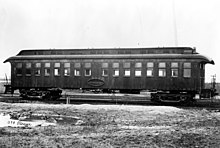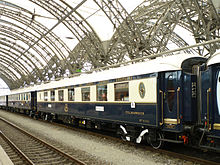Pullman car
Different types of railroad cars are referred to as Pullman cars . The name mostly refers to the luxurious sleeping and saloon cars built by the American Pullman Palace Car Company and operated on the North American railway network, or to the comfortable saloon cars introduced in Europe in the 1920s by the Compagnie Internationale des Wagons-Lits . In addition, “Pullmanwagen” became an umbrella term or nickname for various, particularly comfortable rail and tram vehicles.
Pullman cars in the USA
The term is derived from George Mortimer Pullman , an American entrepreneur. He was the founder of the Pullman Palace Car Company in Pullman City near Chicago . He developed particularly luxuriously equipped sleeping , dining and saloon cars , the latter called "parlor cars" in American usage. He provided the vehicles to the long-distance trains of the major US railroad companies on his own account. These Pullman cars were built exclusively as bogie cars. The cars were characterized by the use of particularly comfortable seating and sleeping facilities as well as a rich interior.
Pullman car in Great Britain
After the Pullman Palace Car Company had started to use their cars in Europe in 1876 , the term was also used for the company's European sleeping cars, which competed with the CIWL's sleeping car for several years , especially in Great Britain and Italy . While the CIWL managed to eliminate competition from the Pullman company on the continent relatively quickly, it remained active in Great Britain, but gave up the sleeping car business after a few years. In contrast to most continental railways, the sleeping car operation has since been taken over by the British railway companies themselves.
In 1906 the American parent company sold the British company, the Pullman Car Company (PCC), to the publisher and politician Davison Dalziel . After the First World War , the CIWL took over the British company from Dalziel, who was appointed Chairman of the Board of Directors of the CIWL. However, this takeover was kept secret for many years, officially the CIWL only stated that it was working on friendly terms with the British Pullman company. Since 1881, the Pullman company sat down next to the sleeping car in the British routes particularly luxurious saloon car , which from the a compartment car running saloon car itself CIWL clearly distinguished and also by the company the name Pullman received. The on-site service was characteristic of these Pullman cars . From 1932, the PCC also used Pullman cars in the form of electric railcars with the Brighton Belle between London and Brighton .
In Great Britain, British Railways (BR) and the British Transport Commission took over PCC in 1954. BR was still purchasing new Pullman cars in the 1960s. In addition, BR also put diesel multiple units ( BR class 251/261 ) with Pullman equipment into service. In the 1970s, however, BR parked most of the Pullman cars, and the “Manchester Pullman” between Manchester and London remained the last train with a Pullman car until 1985 .
Pullman cars in continental Europe
From 1925, the CIWL also introduced luxury trains with Pullman cars on the continent , after having only used sleeping and dining cars as well as conventional saloon cars in their luxury trains. These trains, known as the Pullman Express or Pullman suit , initially only had 1st class cars and were offered as a comfortable day connection with service at the seat. In addition to luxury trains composed entirely of Pullman cars, the CIWL and the British Pullman Company also used individual Pullman cars that were placed in normal express trains. The wagons ran mainly in France , the Benelux countries, Italy and Romania , and there were also individual train and wagon runs to Switzerland . About half of the Pullman cars used had a kitchen. As a rule, a car without and a car with a kitchen were used together as a so-called coupling position. The oval windows in the outer doors, the toilet rooms and in the corridor opposite the toilets were characteristic of these cars. The first-class Pullman cars had tables with two armchairs on either side of a central aisle and four-seat compartments at both ends. The first series for use in the Sud-Express and the Flèche d'Or were given a cream-brown color, analogous to the British Pullman cars. From 1927 the other series were delivered in crème blue, the older cars were also given this color from 1932. As a further development of the 1st class Pullman coach, the Côte d'Azur type appeared with one fewer seating group, adjustable armchairs and more legroom. Starting with the wagons for the Étoile du Nord , CIWL also procured 2nd class Pullman wagons, which were initially only used in individual trains. The second-class Pullman cars had tables with two or four seats and a central aisle. In the course of the global economic crisis , the CIWL introduced the Pullman coaches for 2nd class in general, only the Sud-Express and the Flèche d'Or were reserved exclusively for 1st class for a few years.
CIWL's Pullman coaches ran to Germany exclusively on one train route, the Ostend-Cologne-Pullman Express , which ran between 1929 and 1939 . The only Pullman cars that did not belong to the CIWL were procured from 1928 by the Deutsche Reichsbahn for their new long-distance express train (FD) Rheingold . The concept corresponded to that of the CIWL, but the cars were not referred to as Pullman cars for trademark reasons.
There was also a pullman suit on meter gauge, the Golden Mountain Pullman Express of the Montreux – Berner Oberland Railway , which only ran in the summer of 1931 and was then discontinued for lack of success. For this train, four new cars were built for the CIWL based on the model of the MOB car AB4 75 (later As 102) with three-part viewing windows built in 1915. In 1939 these cars were sold to the Rhaetian Railway , where they are still available today as the Alpine Classic Pullman Express for special trips. In 2004, the MOB converted four cars for the scheduled Golden Pass Classic train, which were inspired by the CIWL Pullman cars.
With the outbreak of World War II , the Pullman cars were stopped. After the war, some of the cars were put back into service and express trains were provided until around the mid-1960s, especially in France and Italy. With the Europe-wide introduction of the two-class system in 1956, all Pullman cars were classified as 1st class. A large part of the 2nd class Pullman car was converted into dining car, including for the first post-war generation of the Rheingold . Pullman cars were also used on the Simplon Orient Express on a trial basis, but were soon withdrawn due to lack of demand. As one of the few pure Pullman suits, the Sud-Express remained on its French section between Paris and Irun for a few years . Until 1969 the TEE Mistral ran a 1st class Pullman car, which was equipped with new bogies and air conditioning for this purpose. The last pre-war Pullman cars - new cars were no longer built for continental Europe, unlike for Great Britain, after the war - were withdrawn from scheduled use in France and Italy in 1971, but were used by the CIWL for a few years for special services.
Some of the old Pullman cars were acquired by the operators of the Nostalgie-Istanbul-Orient-Express and the Venice Simplon-Orient-Express as well as various museum railways . The renovated cars are used in charter trains across Europe. Other cars are in railway museums, such as car 4018 in the Cité du Train in Mulhouse, France .
CIWL Pullman cars outside of Europe
From 1926, the CIWL also started using Pullman cars outside of Europe. It initially introduced individual Pullman cars in Egypt, from 1929 until the outbreak of war the Sunshine Pullman Express ran between Cairo and Luxor . In contrast to the European CIWL cars, the cars received a white exterior paintwork, the armchairs were not covered with fabric, but leather. After the Second World War, the cars became the property of the Egyptian State Railways .
In 1937, CIWL shipped two Pullman cars along with eight sleeping cars to Hong Kong on the “ Belpamela ” freighter, which specializes in transporting rail vehicles . A planned deployment in China failed because of the outbreak of the Sino-Japanese War .
Other vehicles known as Pullman cars
For the first time tram cars (GLSt or LVB types 22 and 56) with skylight roofs pulled down at the front and rear were procured for the Leipzig tram in 1925 , which were soon nicknamed "Pullman cars" because of their external similarity. The ET505 series of railcars of the Cöln-Bonner Kreisbahnen (later KBE) have the same peculiarity . Due to their comparatively comfortable equipment, colloquially known as “Pullman cars”, the F and G series of the Frankfurt am Main tram, which were also delivered from 1925 onwards . In the case of the Zurich tram , this applied to the Swiss standard cars built from 1940 , and in Romania to the Gb 2/2 and V54 series .
literature
- George Behrend : Great Express Trains in Europe. The history of the wagon lits . Orell Füssli Verlag, Zurich 1967
- George Behrend: History of Luxury Trains. Orell Füssli, Zurich 1977, ISBN 3-280-00918-9 .
- Albert Mühl: International luxury trains . EK-Verlag, Freiburg im Breisgau 1991, ISBN 3-88255-673-0
- Albert Mühl, Jürgen Klein: Traveling in luxury trains. The International Sleeping Car Society. EK-Verlag, Freiburg im Breisgau 2006, ISBN 3-88255-696-X
- Renzo Perret: The history of the CIWL. The Pullman car. Franckh'sche Verlagshandlung, Stuttgart 1986, ISBN 3-44005-612-0
- Hans D. Reichardt, Joachim Deppmeyer: The Blue Sleeping & Dining Cars: A History of the International Sleeping Car Society . Alba Verlag, Düsseldorf 1976, ISBN 3-87094-035-2
Individual evidence
- ^ Albert Mühl, Jürgen Klein: Traveling in luxury trains. The International Sleeping Car Society. EK-Verlag, Freiburg im Breisgau 2006, p. 344
- ↑ George Behrend: History of the luxury trains. Orell Füssli, Zurich 1977, p. 23
- ^ Fritz Stöckl: The great railway routes in the world. Verlag Rasch & Röhring, Hamburg 1985, ISBN 978-3-8913-6046-0
- ↑ Hans Bodmer: Das Tram in Zürich, 1928 to 1962 , p. 11
- ^ First "Cobra" trams in the "Year of the Snake" , Neue Zürcher Zeitung of January 23, 2001






